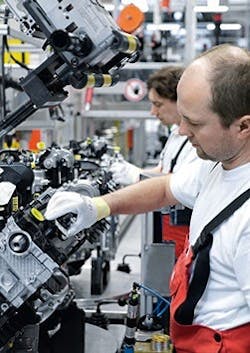Few would argue against the seemingly effortless flight of a bird as the ultimate model of efficiency in motion. And so it is fitting that automation supplier Festo created its bionic SmartBird to embody the trends it sees driving automation technology into the future: energy efficiency, high levels of mechanical efficiency, functional integration and lightweight construction (which also facilitates speed and efficiency in motion control applications).
"Festo has observed these factors in international markets and has taken them as the basis for the development of tailor-made products for its customers all around the world," explained Dr. Ansgar Kriwet, member of the management board region and sales Europe at Festo AG, at the company's international press conference in June 2011 to mark the opening of a Festo plant expansion in Budapest.
A lesson from nature
Festo's SmartBird flies, glides and sails through the air, just like its example in nature− the herring gull. Its wings not only beat up and down but also twist in a specific, controlled way to provide thrust. This effect is produced with an active articulated torsion drive, which in conjunction with a complex control system achieves unprecedented efficiency in flying operation. (See the SmartBird fly video below.)
Its forward propulsion and lift are generated by the beating of its wings and need only about 23 watts of power, despite the fact that SmartBird has a total weight of approximately 450 grams and a wingspan of two meters. SmartBird is thus an example of functional integration, extreme lightweight construction that is also resource-efficient and the optimum use of flow phenomena in air. For Festo, it will provide important ideas for the further optimization of future generations of pneumatic cylinders and valves.
Similarly, the global automation marketplace will require increasing levels of system expertise, functional density, software capabilities, energy efficiency and safety features. "Already today, our system solutions are characterized by function integration, no matter whether in hard-drive test equipment for the electronics industry, servo-pneumatic welding guns for the automotive industry or milking robots," said Kriwet. Other functionally integrated examples from the Festo line-up include actuators with onboard diagnostics and controllers with built-in position sensors.
Efficiency in pneumatics, motion
Sustainability, especially as it relates to energy efficiency, is a central corporate tenet of Festo's—not only its own manufacturing processes but in how it helps its clients to be more energy efficient. "Energy efficiency is a great opportunity, but also poses significant challenges," said Alex Gomeringer, head of innovation and technology management for Festo AB.
At Audi Hungary's production plant in Györ, some 6,900 automotive engines roll off the production lines each day. In addition, some 84,000 finished cars are assembled annually, and a planned 2013 expansion will boost capacity and round out the facility with press, body and paint shop capabilities. In June, 2010, attendees of Festo's ninth annual global media event in nearby Budapest toured the facility and saw how thousands of Festo components and systems are helping the world's largest engine plant achieve new levels of safety and efficiency.
Key elements of Festo's approach to sustainability include the proper dimensioning of automation components (oversized elements tend to waste energy), attention to efficiency in the product specification process, as well as the need for employee training in energy efficiency principles and practices. Festo Energy Savings Services also are available to help customers increase efficiency through pre-assessment, analysis, planning, implementation and sustainment activity phases.
And when it comes to making handling applications more efficient, speed of movement is important—and that directly relates to the sizing and weight of automation components, explained Jӧrg Tertünte, promotion concepts handling and solution. "It's all related to minimum moving mass," he said.
"Energy efficiency is a journey, a direction in which you are moving," added Gomeringer. "It's a pillar of our production system, and is integrated into our culture."
Global approach driving record sales
Thanks to its range of appropriate customer solutions, Festo was able in 2010 to increase its global sales by 37% to a record level of €1.8 billion. Outside Germany, China is now Festo's most important and largest market. "This is not surprising, since the growth markets of China and India will account for almost 40% of the entire global gross domestic product in the next 15 years," said Kriwet.
In order to ensure that Festo continues to occupy a leading position in Asian markets, production and logistics facilities in China will be extended to allow Asian customers to be supplied quickly. Germany and Europe will nonetheless remain important for Festo, Kriwet said.
He also acknowledged that we must prepare for a world in which traditional industrial leaders will need to share the global spotlight. "We must rely on innovation and partnerships around the world," he said."How can we use our creativity, our engineering excellence to participate?"






